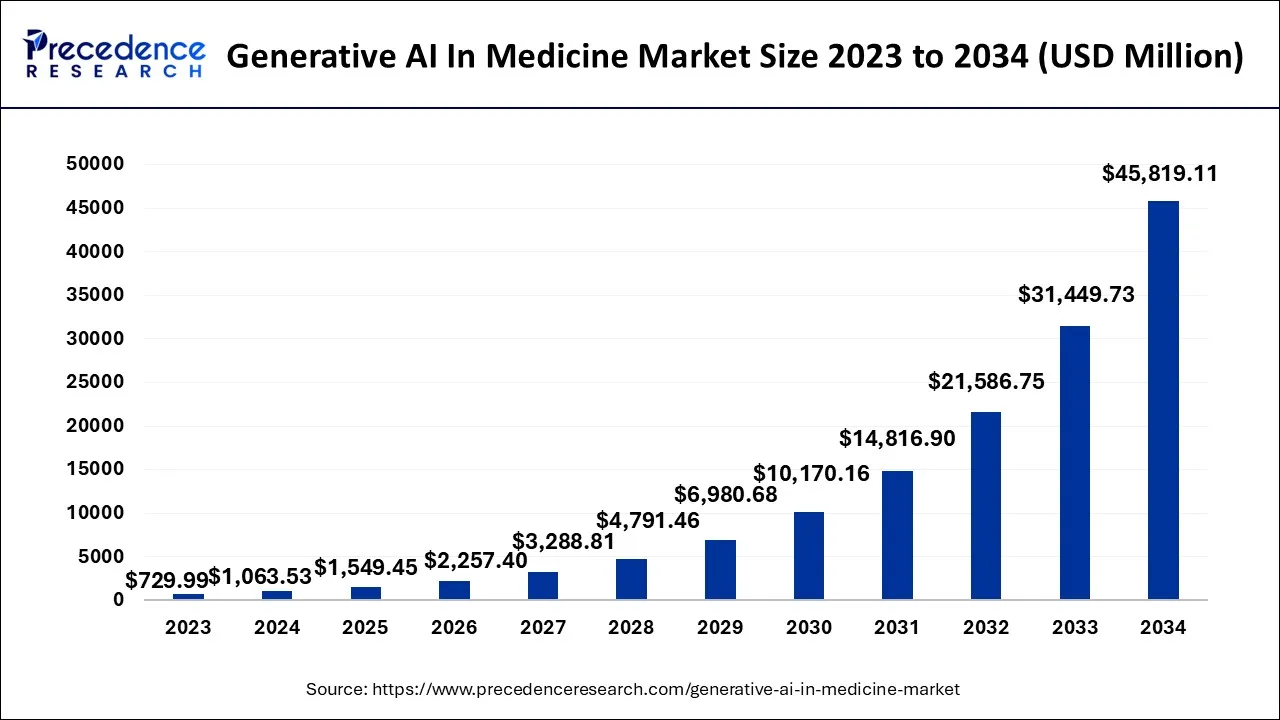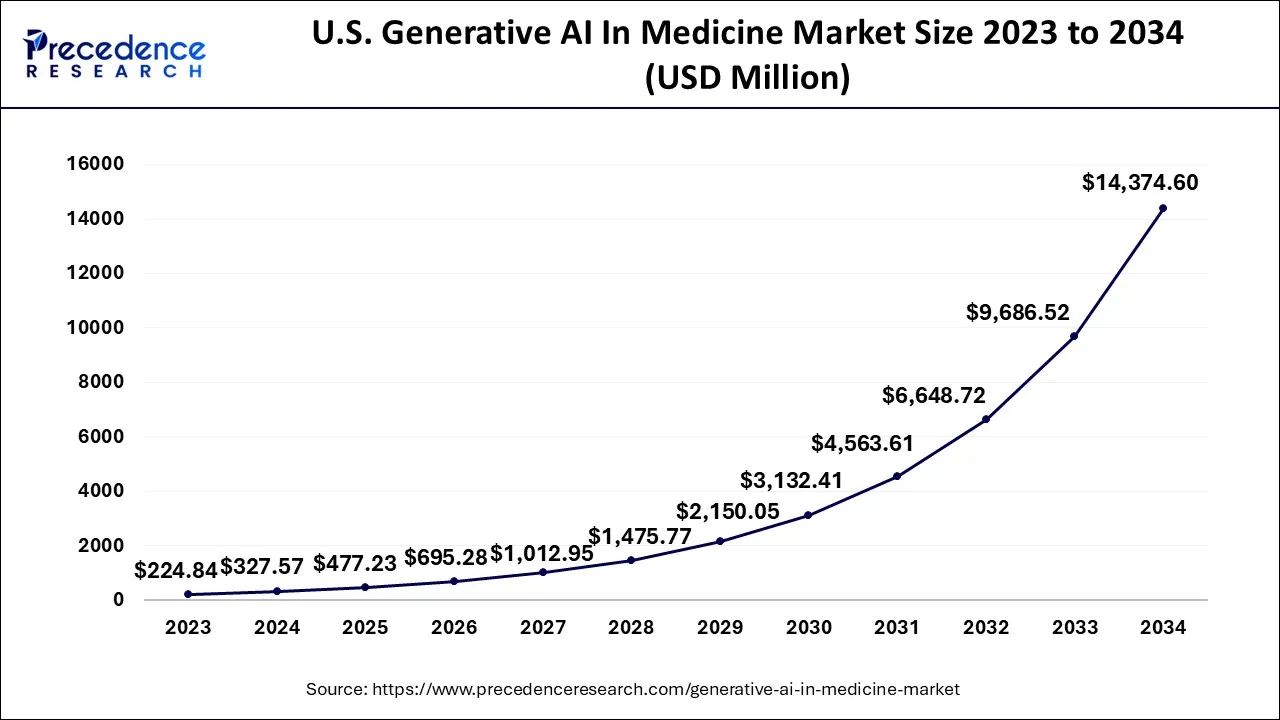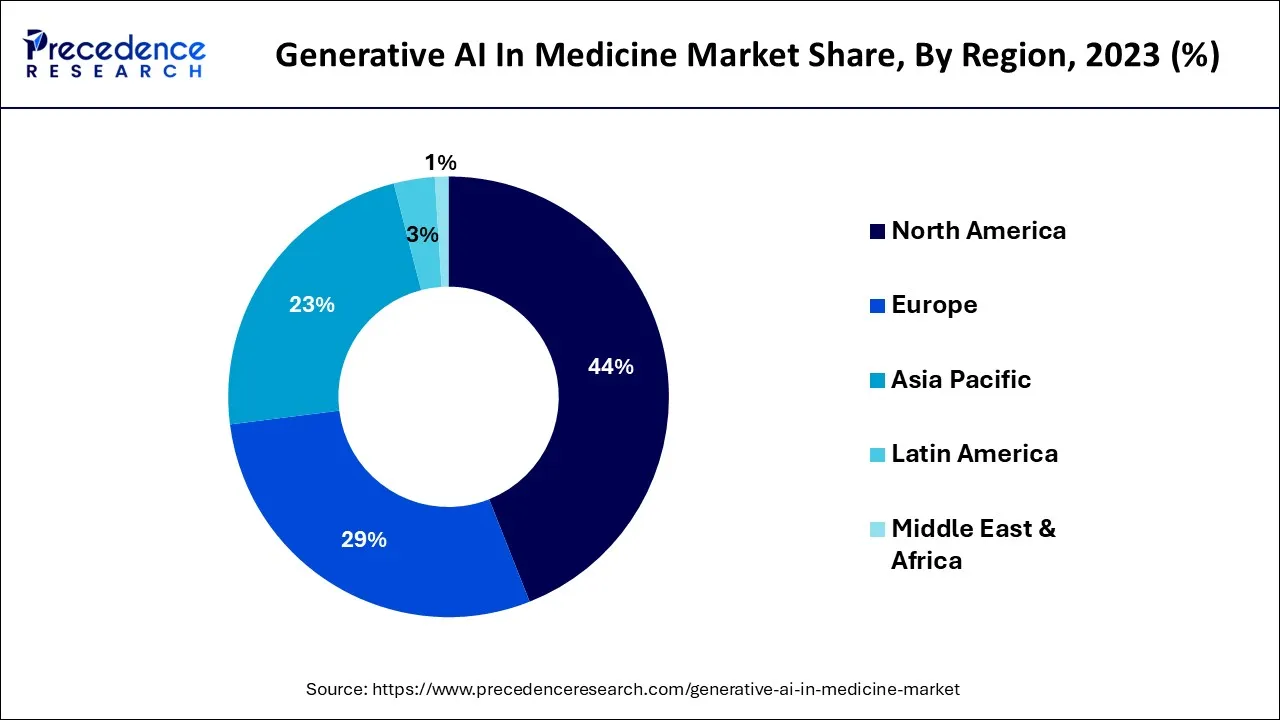List of Contents
What is the Generative AI in Medicine Market Size?
The global generative AI in medicine market size is worth around USD 1,549.45 million in 2025 and is anticipated to reach around USD 45,819.11 million by 2034, growing at a CAGR of 45.69% over the forecast period from 2025 to 2034.

Market Highlights
- By region, North America dominated the market with the largest market share of 44% in 2025.
- Asia Pacific expected to expand at the fastest CAGR during the forecast period.
- By deployment, the cloud segment dominated the market with the largest market share in 2025. While the on-premises segment is expected to show a steady growth in market share during the forecast period.
- By application, the medical imaging segment held the largest market share in 2025, the segment will continue to maintain its dominance during the forecast period.
- By end-user, the hospitals and clinics segment dominated the market with the highest market share in 2023. While the diagnostics center segment is the most emerging segment of the market.
Market Size and Forecast
- Market Size in 2025: USD 1,549.45 Million
- Market Size in 2026: USD 2,257.4 Million
- Forecasted Market Size by 2034: USD 45,819.11 Million
- CAGR (2025-2034): 45.69%
- Largest Market in 2024: North America
- Fastest Growing Market: Asia Pacific
Market Overview
With the technological advancements in every sector, artificial intelligence technology has achieved a significant position. In recent times technology has occupied almost every industry. Being a prominent branch of artificial intelligence technology, generative AI is observed to be the most advanced and faster technology that can assist industries to grow by generating content. Generative AI has the ability to tackle the problems and hurdles that come across in the development of the sector. Medicine is the most emerging sector in the world due to the rise in diseases in the population.
Generative AI could help the medical sector in various ways; artificial intelligence could help with precise diagnostics. It can analyze the disease by examining the patient's data, previous health records, etc. Algorithms of generative AI can provide accurate insights about the condition.
Generative AI In Medicine Market Growth Factors
Generative AI has the capability to transform the medical industry. It can be helpful for industry operators as it provides powerful tools for analyzing the patient's data and helping provide a patient's accurate diagnosis. Generative AI models are capable of offering personalized or customized medicine plans according to the patient's needs. This element is observed to accelerate the market's growth owing to the rising demand for customized treatment plans.
Generative AI in medicine or healthcare can create higher quality medical imaging and recorrect missing or corrupted data. The accurate and precise information collected by analyzing the data will give the exact diagnosis and treatment decisions. Generative AI can minimize the burden of administration. The medical industry contains an enormous amount of data that artificial intelligence can do quickly and effectively. Generative AI informs or predicts the maintenance of medical devices or when they will fail. So, it would be more convenient for the hospital or medical administration to manage the repairs and maintenance of the equipment or devices.
The continuous upgradation of artificial intelligence technology will make the medical industry work faster with improved productivity. Artificial intelligence in the medical industry would solve multiple challenges with the sector's expansion. It maintains a larger amount of data and even manages the procedures associated with drug discovery and development. All these factors significantly impact the growth of generative AI in the medicine market.
Market Scope
| Report Coverage | Details |
| Market Size in 2025 | USD 1,063.53 Million |
| Market Size in 2026 | USD 2,257.4 Million |
| Market Size by 2034 | USD 45,819.11 Million |
| Growth Rate from 2025 to 2034 | CAGR of 45.69% |
| Largest Market | North America |
| Fastest Growing Market | Asia Pacific |
| Base Year | 2025 |
| Forecast Period | 2025 to 2034 |
| Segments Covered | Deployment, Application, End-User, and Region |
| Regions Covered | North America, Europe, Asia-Pacific, Latin America, and Middle East & Africa |
Market Dynamics
Drivers
Accurate and real-time data offered by generative AI
Healthcare procedures throughout the world have already been altered by artificial intelligence. Examples of innovations include appointment scheduling, translating clinical information, and maintaining patient histories. Healthcare institutions are now able to automate more time-consuming and delicate activities owing to the power of generative AI. Sophisticated radiological equipment can recognize important visual indicators, saving hours of meticulous investigation. There are also automated methods for arranging appointments, monitoring patients, and making suggestions for care. Reviewing health and life insurance is one specific duty that generative AI streamlines. Generative AI is utilized to reduce expenses brought on by denied insurance claims. Healthcare providers may find and correct incorrect claims with the help of AI algorithms. The hospital personnel no longer have to spend time going through resubmitting the healthcare-associated data. All these factors are expected to boost the adoption of generative AI systems in the medical sector by promoting market growth.
Restraint
Lack of diverse data
Medical data is often unstructured, fragmented, and stored in various formats, such as electronic health records (EHRs), medical images, and clinical notes. This lack of standardized data poses challenges in preprocessing and harmonizing the data for use in generative AI models. Incomplete or inconsistent data quality can lead to biased or unreliable model outputs. Generative AI models rely on diverse and representative data to produce accurate and generalizable results. In medicine, obtaining a diverse range of patient data, covering various demographics, clinical conditions, and medical procedures, can be challenging. The lack of diversity in the available data can lead to biased or incomplete models, limiting their reliability and applicability. Thus, the lack of diverse data for generation acts as a major restraint for the market.
Opportunity
Ongoing technological advancements
Researchers continue to develop and refine algorithms and models for generative AI in medicine. Novel approaches, such as variational autoencoders (VAEs), generative adversarial networks (GANs), and transformer-based models, have shown promise in generating realistic medical images, synthesizing patient data, and aiding in medical diagnosis and treatment planning. Generative AI models can be used to augment and synthesize medical data, addressing the issue of limited labeled data. By generating synthetic data, these models can help overcome data scarcity challenges and enhance the training process for other AI algorithms. This facilitates better training and more accurate predictions in medical applications. Overall, ongoing technological advancements provide opportunities for generative AI in medicine to revolutionize healthcare delivery, improve patient outcomes, and contribute to scientific advancements in the field.
Segments Insights
Deployment Insights
The cloud-based segment dominated the market with the highest market share in 2024, the segment is expected to acquire a significant share of the market during the forecast period. Through increased efficiency and decreased dependency on on-premises equipment, cloud technology may make healthcare systems more cost- and sustainably effective. Telemedicine and online consultation are expanding alternatives for conventional consultation measures. Patients now have remote access to their health information, test results, and medications due to cloud-based technologies. Healthcare practitioners are now able to monitor chronic conditions, give remote treatment, and even perform procedures with the help of cloud-based deployment. All these factors and the additional capabilities of generative AI promote the growth of the segment.
Application Insights
The medical Imaging segment dominated the market with the highest market share in2024, the segment is expected to be the most attractive segment of the market during the forecast period. The growth of the segment is attributed due to the increased use of generative AI solutions by the healthcare system for better and earlier diagnosis of patients. Early disease detection leads to more effective therapy. It can considerably help to reduce costs in healthcare on a worldwide scale when its use is broadened beyond the field of diagnosis and into the domains of prevention and therapy. Medical imaging when deployed with generative AI platforms comes at a fair price. It improves and increases the effectiveness of the healthcare sector.
On the other hand, the drug discovery segment is expected to register the fastest rate of growth during the forecast period. Generative AI techniques can be used to optimize drug properties, such as solubility, bioavailability, and selectivity. By exploring chemical space and iteratively generating and refining molecules, AI algorithms can generate drug candidates with improved properties, increasing the likelihood of success in preclinical and clinical development.
End-User Insights
The hospital and clinics segment is expected to grow at a significant rate while sustaining its position in the market during the forecast period. The growth of the segment is attributed to the increasing use of generative AI in medicine by hospitals and clinics for various healthcare purposes. Hospitals and clinics use generative AI for the analysis of patient data, drug research, medical image, etc. Algorithms of generative AI can be very useful for the hospital with which they can analyze the medical data and images much more effectively without human intervention.
Moreover, many hospitals and clinics actively engage in research collaborations with academic institutions, technology companies, and startups. These partnerships facilitate the development and validation of generative AI models in a real-world clinical setting.
On the other hand, the diagnostics center segment is expected to grow at a significant rate during the forecast period. Diagnostic centers typically have access to extensive medical databases and patient records, including imaging data, pathology reports, and clinical data. These datasets provide a valuable resource for training generative AI models, allowing them to learn from a wide range of cases and improve their accuracy and performance.
Regional Insights
U.S. Generative AI In Medicine Market Size and Growth 2025 to 2034
The U.S. generative AI in medicine market size is accounted for USD 327.57 million in 2025 and is projected to be worth around USD 14,374.60 million by 2034, poised to grow at a CAGR of 45.96% from 2025 to 2034.

North America dominated the market with the largest market share in 2025.The rapid adoption of artificial intelligence-based solutions by the medical sector in the region is observed to be the major factor behind the growth of the market. North America has a well-established ecosystem of startups, that foster innovation in artificial intelligence technology for numerous fields and industries. Along with this, government initiatives and private investments that promote the adoption of generative AI solutions for the growth of the medical field act as a growth factor for the market in North America.
The United States food and drug administration has already stated the potential of generative AI in healthcare sector, which is establishing guidelines and frameworks to ensure the safe and effective use of these technologies. This element promotes the growth of the market in North America.

Asia Pacific is expected to acquire a significant share of the market by witnessing significant growth during the forecast period.Rising healthcare expenditure in the region is promoting the potential for enhancing medical research activities. This element is expected to highlight the rapid adoption of generative AI platforms in the region. Countries such as China, Japan, India and South Korea are on the edge of technological advancements, these countries have the potential of researchers, and engineers along with a strong IT industry. All these factors collectively supplement the growth of the market.
Moreover, governments in these regions are actively promoting the research and development of AI-based technologies. For instance, China has launched New Generation AI Development Plan to drive AI innovation, this element is observed to fuel the growth of the market in Asia Pacific.
Generative AI in Medicine MarketCompanies
- Nuance Communications, Inc.
- IBM Corporation
- Microsoft
- NVIDIA Corporation
- Intel Corporation
- DeepMind Technologies Limited
Recent Developments
- In June 2023, the Center for Precision Health and Artificial Intelligence announced the launched of “Dartmouth.” It is set to improve the quality and efficiency of precision medicines and health outcomes by taking interdisciplinary research in artificial intelligence and biomedical data.
- In June 2023, the major software solution company for medical aesthetic practices “Aesthetix CRM” launched its pioneering AI Chat Assistant, which is a specified tool for communications for plastic surgeons.
- In June 2023, Google Cloud and Mayo Clinic announced their collaboration in order to transform the healthcare sector by increasing clinical workflow, clinicians in searching for information, clinicians in searching information and improving patient outcomes.
- In June 2023, the leading healthcare service provider that is committed to delivering patient orient and technology-driven healthcare services announced the launch of its new artificial intelligence trainer Mira. AI.
- In June 2023, Mary Ann Liebert launched its “AI in Precision Oncology” the only bimonthly peer-reviewed research dedicated to the artificial intelligence application in precision and clinical oncology.
- In June 2023, DiagnaMed Holdings announced to launch CERVAI the brain age estimation tool in the fourth quarter of 2023. The tool consists of an EEG headset that uses data recording protocols and machine learning techniques to examine overall brain health.
Segments Covered in the Report
By Deployment
- Cloud-based
- On-premises
By Application
- Medical Imaging
- Drug Discovery
- Medical Diagnosis
- Patient Data Analysis
- Other
By End-User
- Hospitals & Clinics
- Clinical Research
- Healthcare Organizations
- Diagnostic Centers
- Other
By Region
- North America
- Europe
- Asia-Pacific
- Latin America
- Middle East and Africa
For inquiries regarding discounts, bulk purchases, or customization requests, please contact us at sales@precedenceresearch.com
Frequently Asked Questions
Ask For Sample
No cookie-cutter, only authentic analysis – take the 1st step to become a Precedence Research client